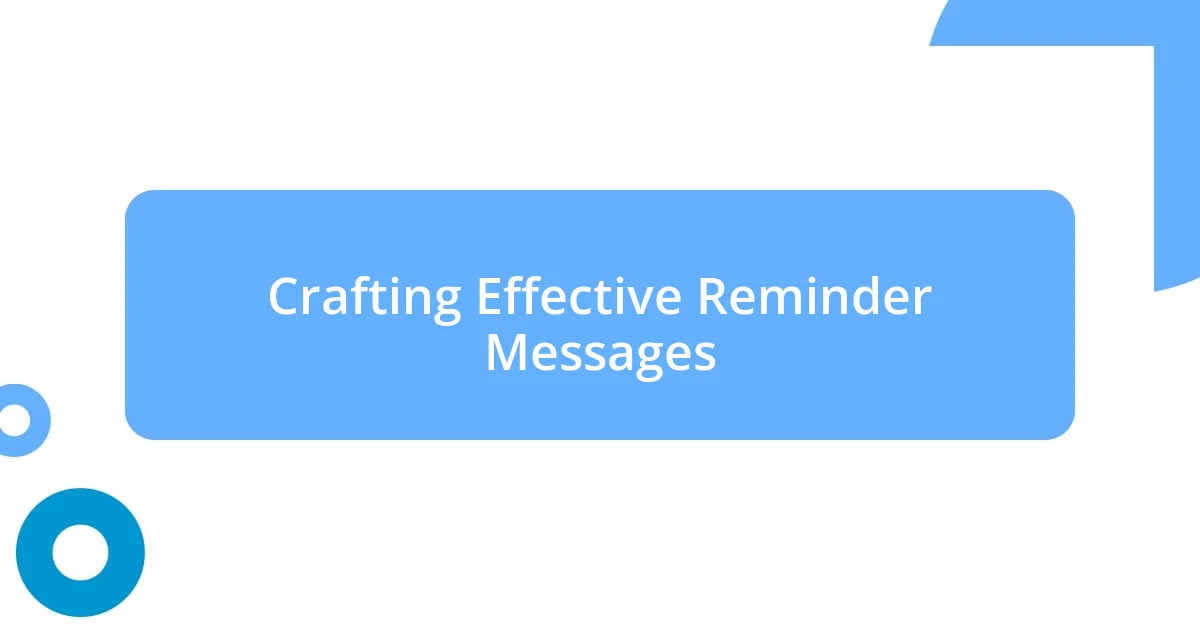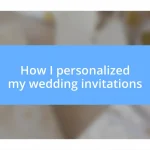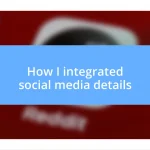Key takeaways:
- Digital RSVPs streamline event planning, allowing real-time attendance tracking and enhancing guest engagement.
- Choosing the right RSVP method is crucial; preferences may vary based on the event’s formality and the audience.
- Utilizing insights from past events can improve future gatherings, encouraging guest involvement and generating excitement.

Understanding Digital RSVPs Importance
Digital RSVPs have transformed the way we plan and manage events, making it simpler and more efficient for both hosts and guests. I remember organizing a wedding a few years back, and using an online RSVP system saved me countless hours. It’s fascinating to think about how a simple click can replace lengthy phone calls or the awkwardness of asking people if they’re coming.
Moreover, the immediacy of digital RSVPs allows hosts to gauge attendance in real-time, which is crucial for catering and seating arrangements. I often wonder how much easier planning would have been without the last-minute surprises of unexpected guests. Digital tools can alleviate that stress, ensuring you have accurate numbers and can keep everyone informed.
Lastly, the emotional aspect shouldn’t be overlooked. When guests RSVP digitally, it shows their engagement and excitement about the event. I can’t help but think about the warmth I felt when my friends promptly marked themselves as attending my milestone birthday celebration online, making me feel truly valued. Isn’t it nice to know everyone is on the same page?

Choosing the Right RSVP Method
Choosing the right RSVP method can really set the tone for your event. Based on my experiences, I’ve found that simplicity often wins. When I planned a small dinner party last year, I opted for a straightforward Google Form. It was user-friendly, and I loved that I could quickly review responses in one place. Guests appreciated the ease, which I think made them more likely to confirm.
Here are some methods to consider for your RSVP needs:
- Email: Classic and familiar; however, it can be easy for guests to overlook a message in their inbox.
- Google Forms: Great for tracking and organizing responses, and you can customize questions to gather specific info.
- Event Platforms (like Eventbrite): Perfect for larger events; they often include additional features like ticketing.
- Social Media: If your event is casual, creating an event page on Facebook can facilitate engagement and quick responses.
- Text Message: Personal and direct, though it may not be suitable for larger gatherings.
Choosing the right method boils down to knowing your audience and what feels authentic to your event’s vibe. I remember when I sent a group text for a casual barbecue; the replies started rolling in almost immediately, creating a buzz that only added to my excitement about the get-together.

Setting Up RSVP Platforms
Setting up digital RSVP platforms can seem daunting, but it doesn’t have to be. I remember when I first dabbled in using an online RSVP system. The initial setup felt a bit overwhelming, yet I quickly discovered how intuitive most platforms are. Typically, you start by deciding on a platform, customizing your event details, and going live. Game-changing, right? Suddenly, managing responses is just a click away, sparing you the hassle of sifting through endless email threads.
While setting up the platform, I recommend considering the design and flow of the RSVP interface. For example, keep the form clean and straightforward. In my experience, when I planned a company retreat, I ensured the RSVP form only had a few essential fields. This simplicity encouraged more responses since guests didn’t feel bogged down by lengthy questionnaires. A well-designed platform reflects your event’s professionalism and enhances guest engagement.
Finally, think about how you’ll communicate your digital RSVP options. I sometimes send a friendly reminder via email or text to make sure everyone knows how to respond. Once, after an invitation mix-up for a friend’s surprise party, I caused quite a stir with last-minute changes. Everyone appreciated a simple follow-up because it kept the excitement alive and ensured they felt part of the planning process.
| Platform | Pros |
|---|---|
| Familiar and direct; good for quick communication. | |
| Google Forms | Customizable; offers seamless tracking of responses. |
| Event Platforms | Ideal for large gatherings; includes features like ticketing. |
| Social Media | Increases engagement; perfect for casual events. |
| Text Message | Personal touch; instant responses for smaller groups. |

Crafting Effective Reminder Messages
Crafting effective reminder messages is all about striking the right balance between being informative and engaging. From my own experiences, I’ve learned that a friendly tone goes a long way. When I send reminders, I often include a personal touch, such as a cheerful greeting or a playful note about how much I’m looking forward to seeing everyone. It’s a subtle way to enhance engagement and remind guests that their presence is genuinely valued.
Timing is also crucial. I remember a time I sent a reminder for an upcoming birthday party just a few days before the event, and the responses came flooding in. I realized that people often appreciate a nudge as the date approaches. I like to use short, clear messages, making it easy for guests to confirm their attendance without feeling overwhelmed by details. For example, a simple note like, “Can’t wait to celebrate! Just a quick nudge to confirm you’re still in for Saturday!” gets straight to the point and keeps the excitement alive.
Don’t forget the power of visuals! I’ve found that including a fun image or a highlight from the event in the reminder can really spark interest. Think about it: Wouldn’t you feel more inclined to respond if you saw a snapshot of the last get-together, capturing everyone smiling and laughing together? Adding that personal touch and visual appeal can change the way people react to your message, prompting them to hop on the RSVP train sooner rather than later.

Tracking and Analyzing Responses
When it comes to tracking responses, the beauty of digital platforms shines through in real-time analytics. I remember a particular event where I had a big guest list. Using Google Forms, I was able to see not just who had responded, but also get insights into the types of responses—did people prefer dinner over lunch? It was fascinating! This ability to analyze trends helped me make informed decisions about seating and catering, ultimately enhancing the guest experience.
In my experience, a simple spreadsheet can be a lifesaver too. After an event, I once found myself compiling responses to see who attended and who missed out. I realized that tracking wasn’t just about tallying headcounts; it was an opportunity to reflect. I even categorized attendees by their level of engagement, which allowed me to tailor my thank-you notes. It’s remarkable how data transforms into deeper connections, right? Have you considered how your responses not only inform an event but also guide your future invitations?
Don’t underestimate the emotional aspect of tracking either. I genuinely connect with my guests’ responses, sometimes feeling a pang of excitement when someone confirms. This emotional investment drives me to follow up with those who haven’t responded yet. I once reached out to a close friend who hadn’t RSVP’d for an anniversary party. As it turned out, he simply forgot—the reminder sparked his enthusiasm! Seeing how your outreach can rekindle relationships reminds me continually of the power of sincere communication in creating memorable experiences.

Engaging Guests Through Follow-Ups
Engaging guests through follow-ups isn’t just about confirming attendance; it’s about nurturing excitement! I recall an event I organized where I sent a quirky, lighthearted follow-up that included a fun trivia question related to the occasion. To my delight, guests responded not only with their confirmations but also with eager answers and playful banter. It felt less like a chore and more like a fun conversation. Doesn’t it make you think about how a personal touch can spark joy in the RSVP process?
I’ve noticed that sending follow-ups at strategic moments can create anticipation. For instance, before a recent dinner gathering, I sent a follow-up that included a sneak peek of the menu. The responses were instantly more vibrant; guests weren’t just attending—they were excited about what to expect. This approach turned my reminders into a preview of an adventure, making guests feel included in the planning process. Can you imagine the thrill of awaiting your favorite dish at a dinner party?
Another technique I enjoy is incorporating a countdown in my follow-ups. When I send out reminders, I might include, “Only three days to go till the fun begins!” This simple phrase has an energizing effect. People react enthusiastically when they realize an event is around the corner; it’s as if the excitement is contagious! I’d love to hear how others create that buzz too—what little touches do you add to transform a basic follow-up into an engaging experience?

Enhancing Future Events with Insights
Utilizing insights from past events can be invaluable for enhancing future gatherings. I can still recall analyzing the feedback from a summer barbecue I hosted. By reviewing attendees’ comments, I discovered people loved the outdoor games but felt the seating arrangement was cramped. This insight led me to completely rethink my layout for the next event, allowing everyone to relax and enjoy the sunshine freely. Isn’t it interesting how a single piece of feedback can improve the overall vibe of your gathering?
Data doesn’t just help logistics; it can also inspire creativity! After tracking RSVPs for a themed costume party, I noticed a trend toward nostalgic themes among several guests. This sparked an idea: why not incorporate a nostalgic photo booth with props from those eras? I can’t emphasize how excitement surged when I shared this twist in my follow-up emails. Suddenly, the event transformed from just a gathering to a creative playground where everyone could share their favorite childhood memories. Have you tapped into such insights to ignite excitement for your events?
Moreover, leveraging social media can be a way to enhance future events too! I remember launching a poll regarding potential activities for my next gathering; it generated many ideas I’d never considered. Guests felt involved in the planning process, leading to greater enthusiasm for attending. When I followed up with “Thanks for your input; we’re doing a game night!” I saw RSVPs soar! It’s clear that inviting feedback not only builds excitement but fosters a sense of community. Isn’t it wonderful to create an event where everyone feels they have a voice?













